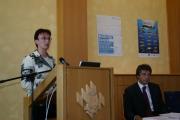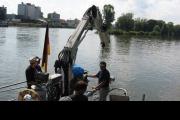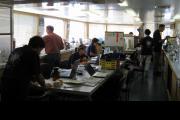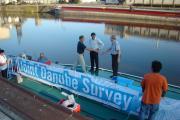The world's biggest river expedition of its kind in 2007 was launched today from Regensburg, Germany. Three ships will travel down the length (2,375 km) of the Danube River and its main tributaries to test pollution and water quality. Costing over one million euros, the entire expedition will last until late September.
Known as the ‘Joint Danube Survey 2 (JDS2)', the expedition has attracted the international cooperation of all Danube countries from Germany to Ukraine. Teams of national scientists will help with sampling and testing on board the ships. Many countries provided large in-kind contributions to the survey such as making available ships from Serbia (Argus) and Hungary (Széchényi).
"The level of excitement and commitment is incredible," says Philip Weller, Executive Secretary of the International Commission for the Protection of the Danube River (ICPDR), the organization coordinating JDS2. "We even have support from scientific laboratories across Europe and the private sector. In more ways than one, the people involved prove that the Danube is truly the world's most international river basin."
The main goal of the survey is to produce comparable and reliable information on water quality for the entire Danube and many of its main tributaries. This will help Danube countries implement the ‘Danube River Protection Convention' which they signed in 1994. It will also help them meet their reporting requirements to the EU's ‘Water Framework Directive' -- possibly the strongest water legislation in the world. Many parameters will be tested, from toxic pesticides and pharmaceutical drugs to heavy metals and bacteria.
"This is also the first time for the Danube that the river's biology will be systematically tested using state-of-the-art technologies," says Weller. "Traditionally, only physical and chemical factors were tested. But EU law now requires biological testing, for example for fish and plankton, to ensure that not only Danube waters are clean, but also that they support life and ecological health."
"The comprehensive, quality data will be comparable across all of the many Danube countries," says Béla Csányi, scientific leader of the JDS Team. "The ICPDR will have some of the most progressive river databases anywhere in the world, presenting information on thousands of species dependent on the river. And national teams will be trained in how to make better tests at home."
Pollution is a major problem in the Danube River Basin. Nutrient, organic and hazardous pollution are all factors that could result in the Danube failing to meet the EU law. Much has already been done nationally and internationally to analyze and reduce pollution, from Cousteau's expedition in 1991 to 1992 to building new wastewater treatment plants.
"The first JDS1 in 2001 had a mix of positive and negative results," says Lucia Ana Varga, ICPDR President 2007 and Romanian State Secretary in the Ministry of Environment and Water Management. "On the positive side, it found high levels of biodiversity and rare species. At the same time, results showed concern over organic and microbiological pollution, heavy metals, oil from ships, pesticides and chemicals."
The results from the JDS2, when they come out in summer 2008, will improve the ability of Danube country leaders to decide on what measures still need to be taken to meet the EU law by 2015. "People want to drink clean water, swim in clean lakes and eat clean fish. We want the JDS2 to help make that happen," says Weller.
Besides testing water, the three ships and their crews will also stop at many cities and towns along the way. Here, in cooperation with local and national representatives, they will actively raise awareness about the Danube and the need to clean up pollution. "Our horns and our flags will be blowing as we enter Danube ports to spread our message," add Csányi. "For those people who won't be able to see us cruise in, we encourage them to go to our website to see what we've seen and heard so far."
View the press release by the United Nations Information Service
View the full-size photos for the press
For further information, please contact:
Mr. Paul Csagoly
c/o Secretariat of the International Commission for the Protection of the Danube River (ICPDR)
Email: paul.csagoly@unvienna.org
Mobile: +43 (0)676 845 200-270


















